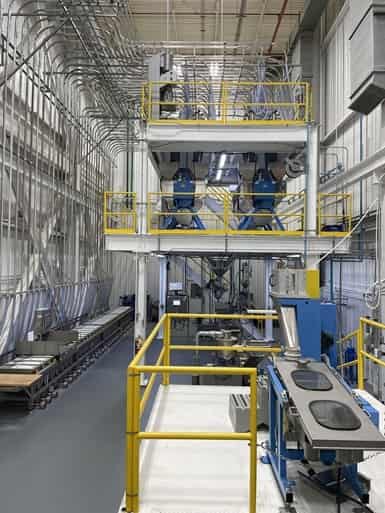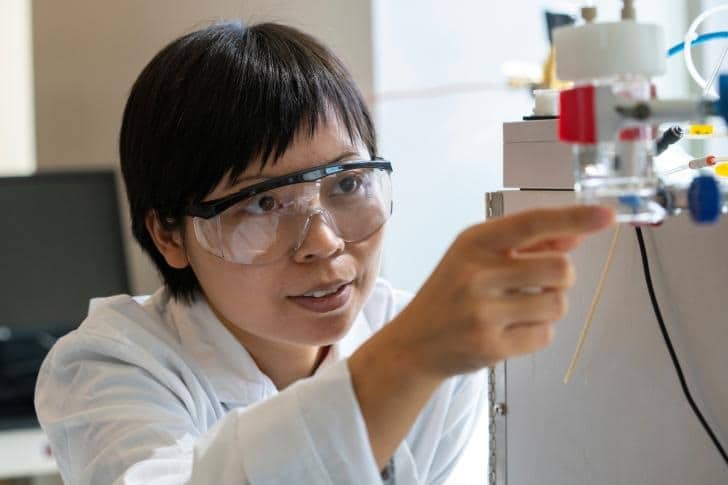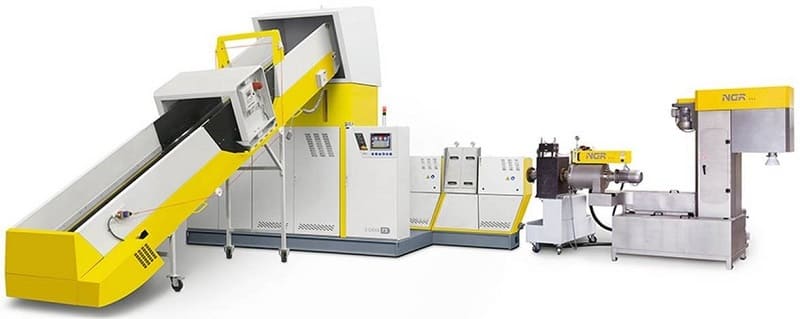Automotive-industry – Bioplastics 05-10-2022 - Arhive
Automotive-industry – Bioplastics
Crude Oil Prices Trend

-Novel System Produces Color on Demand
Ampacet’s FluxQF technology features a quick-dispersion universal carrier with novel machinery that provides automated color blending in quantities down to 50 lb.
Ampacet has developed a streamlined, on-demand color-formulation business with a system that marries the company’s long-standing expertise in masterbatch formulation with unique equipment technology from its 2020 purchase of Israel’s Liad Weighing and Control Systems.
The result, to be marketed by Ampacet’s CISystems (Color Integration Systems), is color-on-demand technology tradenamed FluxQF. Suited for injection molding, blow molding and sheet/profile extrusion, FlexQF teams a proprietary quick-dispersion universal color-carrier technology that is compatible with PE, PP, PET, PS, ABS, PC and PVC and a suite of Liad-developed feeding and blending equipment to automate the color-blending process so that Ampacet can make custom colors as needed in quantities from 50 to 2500 lb. Ampacet says FluxQF is a clean, quick-flow colorant in pellet form that runs like a liquid to provide a more flexible and sustainable alternative to both liquid color and standard masterbatch.
Ampacet has set up a FluxQF line at its production plant in Cartersville, Ga., about 4 miles north of Atlanta. The modular system has a significantly smaller footprint than typical pigment batch-blending systems and eliminates the need to stock hundreds of individual pigments and carrier resins. It’s also pristine, with nary a pellet nor pigment particle on the production floor, as all materials are contained and conveyed to the blending system when called for. In Cartersville, the FluxQF line operates in an environment similar to a clean room. Orders can be produced within two working days and customers receive product within four to five working days.
“The strength of Ampacet has traditionally been in white masterbatch,” notes Douglas Brownfield, commercial director for CISystems/Liad Smart. “But from supplying some of the larger brand owners over the years, it’s become clear to us that the more types of products we can offer the customer, the more value we bring, and the more integrated we become in the markets we serve.”
The line is furnished with a suite of feeding and blending technologies from Liad. These include the Color Save 100 Smart Feeder. This gravimetric feeder provides automatic quick purge between runs; a patented inner floating hopper and isolated load cell to ensure accuracy by negating the effects of vibration; precision weighing at letdown ratios lower than 1%; and ability to integrate with the company’s Spectra 4.0 real-time in-line color-management technology.

-From CO2 to biodegradable plastics
A team of Texas A&M AgriLife Research (College Station, TX, USA) scientists has developed a system that uses carbon dioxide, CO2, to produce biodegradable plastics, or bioplastics, that could replace the nondegradable plastics used today.
The research addresses two challenges: the accumulation of nondegradable plastics and the remediation of greenhouse gas emissions.
Published Sept. 28 in Chem, the research was a collaboration of Susie Dai associate professor in the Texas A&M Department of Plant Pathology and Microbiology, and Joshua Yuan formerly with the Texas A&M Department of Plant Pathology and Microbiology as chair for synthetic biology and renewable products and now Lopata professor and chair in the Washington University in St. Louis Department of Energy, Environmental and Chemical Engineering.
The research was made possible by the John ’90 and Sally ’92 Hood Fund for Sustainability and Renewable Products, Texas A&M AgriLife and Texas A&M University.
Creating bioplastics
Dai said today’s petroleum-based plastics do not degrade easily and create a massive issue in the ecosystems and, ultimately, oceans.
To address these issues, the Texas A&M College of Agriculture and Life Sciences researchers and their teams worked for almost two years to develop an integrated system that uses CO2 as a feedstock for bacteria to grow in a nutrient solution and produce bioplastics. Peng Zhang postdoctoral research associate, and Kainan Chen both in the Texas A&M Department of Plant Pathology and Microbiology, contributed to the work. The Texas A&M University System has filed a patent application for the integrated system.
“Carbon dioxide has been used in concert with bacteria to produce many chemicals, including bioplastics, but this design produces a highly efficient, smooth flow through our carbon dioxide-to-bioplastics pipeline”, Dai said.
“In theory, it is kind of like a train with units connected to each other”, Dai said. “The first unit uses electricity to convert the carbon dioxide to ethanol and other two-carbon molecules – a process called electrocatalysis. In the second unit, the bacteria consume the ethanol and carbon molecules to become a machine to produce bioplastics, which are different from petroleum-based plastic polymers that are harder to degrade”.
Capturing and re-using CO2 waste
Using CO2 in the process could also help reduce greenhouse gas emissions. Many manufacturing processes emit CO2 as a waste product.
“If we can capture the waste carbon dioxide, we reduce greenhouse gas emission and can use it as a feedstock to produce something”, Dai said. “This new platform has great potential to address sustainability challenges and transform the future design of carbon dioxide reduction”.
The major strength of the new platform is a much faster reaction rate than photosynthesis and higher energy efficiency.
“We are expanding the capacity of this platform to broad product areas such as fuels, commodity chemicals and diverse materials”, Dai said. “The study demonstrated the blueprint for ‘decarbonized biomanufacturing’ that could transform our manufacturing sector”.
Expanding future impacts
Dai said currently, bioplastics are more expensive than petroleum-based plastics. But if the technology is successful enough to produce bioplastics at an economic scale, industries could replace traditional plastic products with ones that have fewer negative environmental impacts. In addition, mitigating CO2 emissions from energy sectors such as gas and electric facilities would also be a benefit.

Together with customers, business partners, employees and companions from all over the world, Next Generation Recyclingmaschinen GmbH celebrated its 25th anniversary at the newly built plant in Feldkirchen/Donau on September 16.
Since its beginnings in 1996, NGR has been one of the technological pioneers in the field of sustainable plastics recycling. Driven by the mission “working for a better future”, the company has been building and developing customized recycling machines for Post Industrial Recycling, Post Consumer Recycling and PET Improvement for more than 25 years now.
NGR has a lot to celebrate
A lot has changed since the company was founded. Early on, the recycling specialists focused on internationalisation and today deliver technologies from Upper Austria to the entire world. Fueled by the global demand for resource conservation, NGR has grown strongly in recent years, has continuously developed and has more than doubled the size of the plant in Feldkirchen. The headquarters now employs 180 people regionally, working on intelligent solutions for the plastics industry. “We couldn’t have done it without support,” agree COO, Erich Fürst and CTO, Günther Klammer. “It was time to celebrate our 25th anniversary and thank our customers, partners, highly motivated employees and all supporters. “And what better way to do that than with a big gala, the jubilarians thought, and invited everyone to celebrate together at the newly built plant at the company’s headquarters in Feldkirchen/Donau.
Celebration in the assembly hall
The newly built assembly hall was transformed into a gala stage. The festively decorated location did not suggest that heavy recycling machines had been manufactured here just a short time before. Punctually at 6:00 p.m., the founders and owners welcomed the 500 international guests and let presenter Nina Kraft elicit deep insights into the beginnings of the company. One of the founders, Gerold Barth, recalled how the first recycling machine was assembled on his parents’ farm. “With little capital, but all the more enthusiasm and passion, we worked around the clock on our idea,” Barth reminisced. Josef Hochreiter, CEO of Next Generation Group described another important milestone for the company, recounting how a sailing trip around bays and beaches littered with plastic waste led to the development of new technologies for recycling post-consumer waste. Afterwards, the management thanked all companions as well as the entire staff for their commitment and dedication and gave an outlook on the company’s future plans. After a successful show performance by Jonglissimo, the guests were treated to regional delicacies. The cake, which was personally presented by master confectioner Leo Jindrak to celebrate the day, was the successful finale. With live music, the guests celebrated and danced into the evening hours in the beautifully decorated assembly hall.
Optimistic view into the future
Next Generation Recyclingmaschinen GmbH proudly looks back on an eventful 25 years. However, the Feldkirchen-based company certainly does not want to rest on its laurels and has already developed the next generation of highly efficient recycling machines for a better future.

-TiO2 certified for direct skin contact
Venator has become the first manufacturer and supplier of fibre anatase titanium dioxide (TiO2) to secure an Eco Passport by Oeko-Tex, making it suitable for use in personal hygiene products such as wet wipes, diapers and feminine hygiene products.
The accreditation relates to Venator’s Hombitan LW-S 100 pigment, a premium TiO2 grade for delustering synthetic fibres such as polyester, viscose and acrylic.
Eco Passport by Oeko-Tex is an independent, multi-stage testing and certification system for chemicals, colorants and auxiliaries used to manufacture textiles and leather. Its rigorous evaluation process provides independent proof that raw materials are produced in an environmentally friendly way and under socially responsible conditions.
Hombitan LW-S 100 is an important TiO2 grade in the textile industry, widely used to reduce gloss and create an aesthetically pleasing matt appearance. The pigment also makes yarns easier to spin and improves lightfastness and weather resistance compared to standard pigments.
It is now certified suitable for use in specialist textile applications where there is direct skin contact and where the highest quality standards are required. The certification of Hombitan LW-S 100 will also interest sports apparel manufacturers producing sweat wicking garments.
“Textile producers are increasingly looking to source raw materials with an Eco Passport in place,” said Xandra Bläser, global business director for TiO2 at Venator. “Purchasing ingredients with this quality mark makes it easier for them to achieve the Standard 100 by Oeko-Texlabel. If a garment carries the Standard 100 label, consumers expect that every component – every thread, button, and zip – has been tested for harmful substances and will not have a detrimental effect on their health. With this accreditation our customers have confidence that they are specifying a product from a reliable, responsible partner that adheres to the strictest safety and product stewardship standards.”
To secure Eco Passport by Oeko-Tex status for Hombitan LW-S 100, Venator worked with the testing provider Hohenstein. As part of the accreditation process, Venator’s TiO2 experts had to pass three screening steps.
The product was first cross-checked against lists of harmful chemicals including the REACH substances of very high concern (SVHC) candidate list
It was then tested in an independent laboratory to ensure its suitability for use in the sustainable production of textiles
The final step was a site visit to check that Venator had all the correct systems in place for environmental management, health and safety, quality management and social responsibility.
∼∼∼∼∼∼∼∼∼∼∼∼∼∼∼∼∼∼∼∼
-Suominen unveils new tri-layer nonwoven
Suominen has launched a new premium nonwoven with a unique tri-layer structure and high-definition patterning which, the company says, enhances its cleaning capabilities.
Branded as Fibrella Strata, the tri-layer nonwoven has been designed to deliver an exceptional combination of strength and softness across a number of application areas.
“When developing Fibrella Strata, Suominen used its process know-how to create a nonwoven that has a high-definition pattern,” said Tara Millar, Manager, Category Management, Americas. “The product maintains the pattern when wet to help enhance its cleaning performance and bulk softness. Fibrella Strata’s unique tri-layer structure makes it stand out on the market. It is a combination of everything you need for effective cleaning with excellent opacity at a lower basis weight. Due to its excellent stability and great strength profile, it is perfect for easy converting and one-at-a-time dispensing, saving time and money.”
Although suitable for a multitude of industries and applications, the cleaning performance of Fibrella Strata is said to make it ideal as a premium nonwoven for the hygiene, personal care, and in particular, the baby sector.
∼∼∼∼∼∼∼∼∼∼∼∼∼∼∼∼∼∼∼∼
-Solvay expands Amodel PPA capacity to address growth in demand in the automotive industry
Solvay announced it is increasing its Amodel® polyphthalamide (PPA) resin capacity by 15% at its Augusta manufacturing site in Georgia as a result of operational excellence initiatives, said the company.
The new capacity facilitates the production of innovative and more sustainable Amodel® PPA grades that offer a reduced CO2 footprint due to manufacturing improvements.
Recognized as one of the most strategic product families for the Materials Global Business Unit, Amodel® PPA has played a critical role in replacing metal in the automotive industry for more than 30 years. Today, as the automotive industry continues to move toward electrification, the Amodel® PPA family is finding use in battery electric vehicles (BEVs), in electric motors, power electronics and battery technologies.
“Driven by the needs of our customers and society, Solvay is not only investing in additional capacity, but also in new breakthrough Amodel® PPA resins for e-mobility and in sustainability at our manufacturing sites.” said Brian Baleno, Head of Marketing Automotive at Solvay.
The Augusta manufacturing site has made substantial progress in addressing sustainability, dramatically decreasing the plant’s global warming potential by 30% since 2013. Today, 100% of the electricity sourced by the site is renewable, a major step in carbon footprint reduction. Additionally, the plant has reduced water consumption and non sustainable waste by 15% and 30%, respectively, compared to a 2018 baseline.
Solvay’s continued investment in Amodel® PPA demonstrates a clear commitment to PPA and automotive transition to e-mobility. The company recently introduced two new product ranges, Amodel® PPA Supreme and Amodel® PPA BIOS, which are designed to meet new challenging requirements of e-motors, power electronics and batteries.
Solvay announces a new action plan to reduce limestone residues released into the sea from Solvay Chimica Italia’s soda ash production in Rosignano, as part of the Group’s efforts to continually optimize the efficiency and sustainability of its operations, and in line with the IPPC* permit renewed in January 2022.
The action plan represents an estimated €15 million investment in new technical and process solutions, some of which will require approval by the authorities. The plan will include targeted improvements at different steps of the production process, as well as an optimization of the limestone granulometry and quality.
We remind, Solvay Ventures, the Company’s venture capital fund unit, is extending its partnership with Longwater Investment by investing in the Longwater Advanced Materials Fund II, a fund focused on advanced materials and chemistry-related technologies in China. This investment will support innovation in new and sustainable chemistries that can be used in key markets such as transportation, electronics and smart devices.
∼∼∼∼∼∼∼∼∼∼∼∼∼∼∼∼∼∼∼∼
-Trinseo eyes potential closure of German styrene plant
Trinseo, a specialty material solutions provider, announced it has initiated an information and consultation process with the Works Council of Trinseo Deutschland GmbH regarding the potential closure of its styrene monomer production site in Boehlen, Germany, said the company.
The facility, which has a nameplate annual capacity of 300 kilotons, generated negative profitability of approximately USD30 million over the last four quarters ending Q2 2022.
Frank Bozich, President and Chief Executive Officer of Trinseo, commented, “Given the current economic outlook of higher inflation, lower customer demand and elevated energy costs, we are evaluating asset optimization across our portfolio.”
Bozich continued, “The cost position of the Boehlen facility is challenged due to the current energy cost environment in Europe as well as the facility’s smaller scale, and it’s difficult to envision significant earnings improvement at the site in the near to medium term. Therefore, we have decided to evaluate the potential closure of this plant. In addition to improved profitability for Trinseo, we believe a closure will aid in achieving our 2030 sustainability goals, as Boehlen is one of our most carbon intensive plants.”
We remind, Trinseo announced that it has appointed Han Hendriks to the newly created role of Chief Technology Officer (CTO), effective Oct. 1, 2022. As CTO, Hendriks will be a member of Trinseo’s executive leadership team and will be based in The Netherlands. In this role, he will drive the development of differentiated technology and innovation, allowing Trinseo to meet unfilled and unrecognized customer needs and develop sustainable solutions across Trinseo’s innovation pillars.

-Novamont goes ahead with the redundancy fund
The extremely unfavorable conditions that led to the reduction of production at the Terni site have not changed for the producer of bioplastics.
The Italian producer of bioplastics and biochemicals Novamont has announced that it will go ahead with the redundancy fund at the Terni plant, “The extremely unfavorable conditions that led to the CIGO request have not changed”, as stated by the same company in a note.
It will then proceed with the use of additional weeks of ordinary rolling layoffs, within the 13 weeks originally planned.
Novamont also announced that it has started the procedures for an application for an environmental protection development contract for investments in new innovative circular economy processes.
The layoff was requested in June, starting on 25 July, for an initial duration of four weeks. The decision to temporarily reduce production at the Umbrian site was motivated by the sharp increase in the prices of raw materials and energy, aggravated by the system costs of the Polymer site in Terni and by unfair competition from fossil-based products from Asia
∼∼∼∼∼∼∼∼∼∼∼∼∼∼∼∼∼∼∼∼
